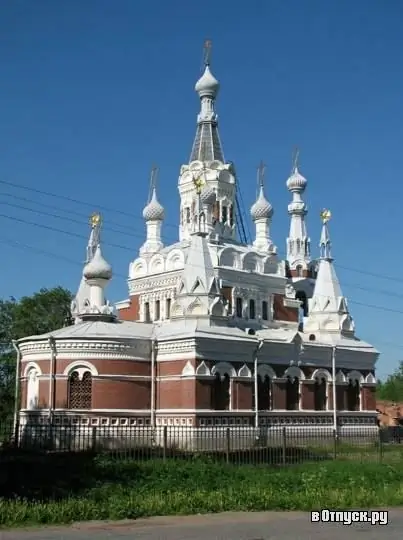
Description of the attraction
In Pavlovsk, on Artilleriyskaya Street, at house number 2, there is a functioning Orthodox Church of St. Nicholas the Wonderworker, dedicated to the memory of Emperor Paul I. The rector of the cathedral is Archpriest Valery Shvetsov.
In 1841, the consecration of the Nikolskaya Church took place in the barracks of the Exemplary Cavalry Regiment. In 1868 the regiment was transferred, and the temple went to the 5th battery of the Guards Horse-Artillery Brigade.
The temple was marching - it was not heated, there were no books for divine services. The iconostasis was brought here from the Tsarskoye Selo Znamenskaya Church. There was no permanent priest in the church, the services were performed by local parish priests. In 1894, priest John Zhemchuzhin was assigned to the church, and the church was assigned to the Sergiyevsky artillery cathedral.
Several times they wanted to move the temple, but a positive response to inquiries was never received. In 1902, the wooden church was dismantled, and a cross was later installed in its place.
After addressing John of Krondstadt and with his blessing, Father John Zhemchuzhin began collecting funds for the construction of a new church. The first benefactor was John of Krondstadt.
According to the first project, which was developed in 1898, the construction of a new temple should have been relatively inexpensive. However, the Grand Duke Konstantin Konstantinovich, with whom the project was coordinated, was dissatisfied with the sketches and ordered to build a church without saving money. The second project was developed by the architect A. Carbonier. However, the prince did not like his work either. He wished that the temple would resemble the Church of the Icon of the Mother of God of All Who Sorrow, Joy, built at the Porcelain Factory. The priest Zhemchuzhin turned to its architect A. von Gauguin. Von Gauguin made the sketches free of charge. In March 1900, Gauguin's project was approved by Prince Konstantin Konstantinovich.
The temple was assigned a site not far from the former wooden temple. On June 18 (30), 1900, the ceremony of laying the first stone took place. When most of the construction work was completed, St. Nicholas Cathedral was consecrated. The ceremony took place in August 1902 in the presence of members of the royal family. After the consecration, the position of the rector of the temple became regular. The construction was finally completed in 1904.
After the revolution, the temple continued to work until 1930, but in November 1930 they tried to close it. Then the prosecutor's office of the republic considered the actions of the officials illegal. In November 1933, the church was closed. The building of the temple was transferred to 32 motorized brigades. For some time there was a club, and then there were repair shops.
During the Great Patriotic War, the church was badly damaged during shelling. In 1941, despite the fact that the building of the temple was in a deplorable state, services were resumed there. After the end of the war, workshops were again housed in the church. The interior layout has been refurbished. In 1960, a military warehouse was placed in the building.
In 1987, the church building was recognized as an architectural monument and taken under state protection. In the early 90s, the church was returned to the parishioners. In 1991, the first prayer service was held there. Later, the temple was included in the list of objects of cultural and historical heritage of Russia. Restoration work in the temple took almost 10 years.
The building of the cathedral was built in the Russian style. The walls are lined with red bricks. The cathedral is five-domed, in plan it is square, with a semicircular protruding apse. In the central hall there were three images: Michael the Archangel, St. Nicholas the Wonderworker, George the Victorious. The large bell weighed about 3 tons. The carved oak iconostasis was made according to a sketch by the artist Subbotin.






